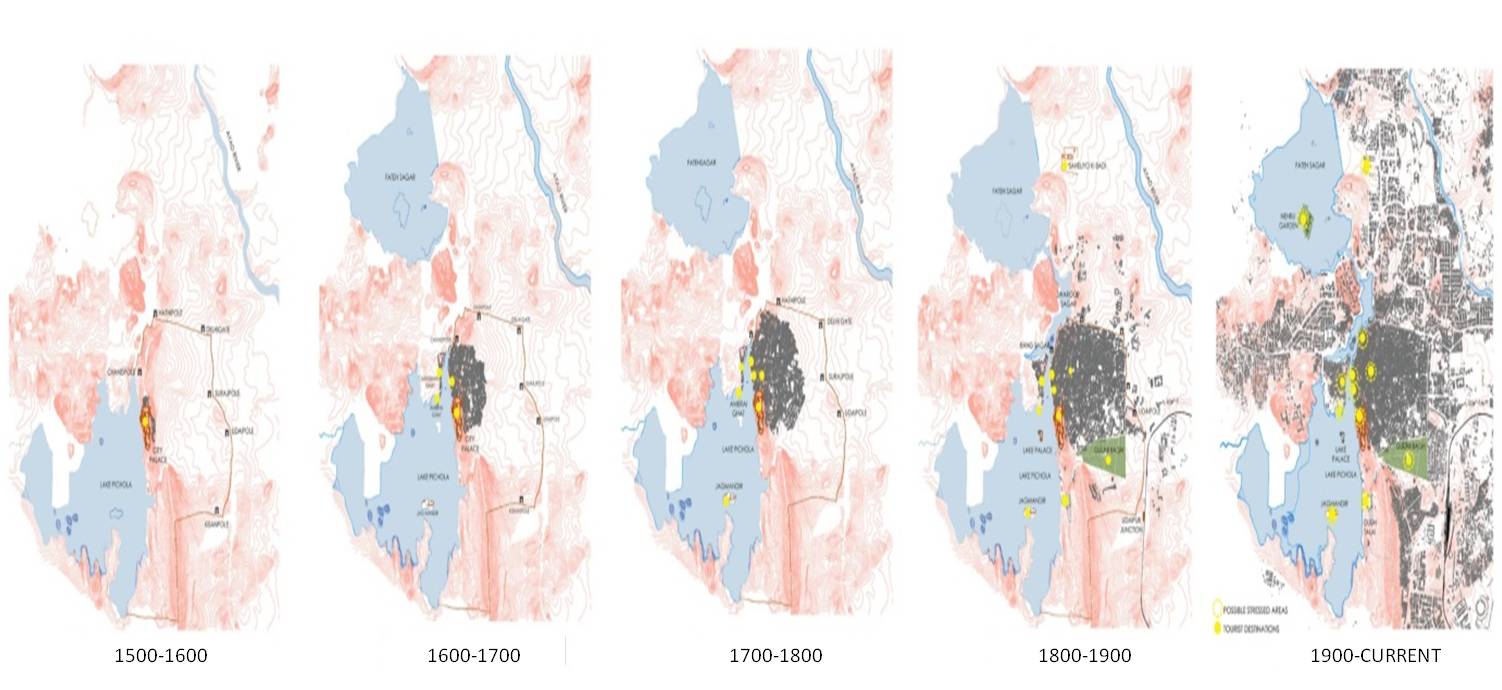UDAIPUR - The emerging urban phenomenon
The peri-urban and urban fringes have witnessed growth and have become self-sufficient neighbourhoods. All these are facilitated by the changing aspirations of its citizens to paint Udaipur a world class city. However what lacks is the holistic understanding of urban planning and development in the city.
The urban coverage in Udaipur has increased from 17 km2 in 1946 to 221 km2 in 2011, while the density of population in the city area has been found to decline from 4347 persons per km2 in 1946 to 3773 persons per km2 in 2011. The high growth rate of population in urban areas has increased the urban demand for agricultural commodities on one side and widened the demand for land for the construction of houses, roads and other civil amenities in urban areas on the other side. With the expansion of urban areas on all sides of the cities the rural areas adjoining them were changed to peri-urban in terms of facilities, amenities and lifestyle.
Cities in India are emerging as major economic hubs with an unprecedented land use changes and decline of environmental resources. Globalisation and consequent relaxations of Indian markets to global players has given impetus to rapid urbanisation process. Urbanisation being irreversible and rapid coupled with fast growth of population during the last century, contributed to serious ecological and environmental consequences. This necessitates monitoring and advance visualisation of spatial patterns of landscape dynamics for evolving appropriate management strategies towards sustainable development approaches. (H.A. Bharath, M.C. Chandan, S. Vinay, T.V. Ramachandra, 2018)
Known for its scenic beauty and royal grandeur, Udaipur has carved a niche for itself as a promising city. Udaipur has grown from an agricultural economy to a hub of mineral and extraction industry in the later part of last century. Tourism has become a major industry and economic gain for the city of Udaipur. With these transitions in economic sphere, the spatial and urban morphology has transformed in the city.
The socio-cultural dimension of Udaipur has witnessed transformation at massive scale, changing the morphological conditions, pattern of land use, zones of contact and sociability, public interaction and spatial narrative of the city. It is the consumption pattern of global culture and aspirations of luxurious lifestyle that has been a major influence on urban citizens.
Tourism, city branding through its Heritage, Art and culture, Global festivals based on Music, Dance, Cuisine, Fashion and apparel amongst others have completely changed the landscape of Udaipur. This has been fuelled by the adaptation of national urban policies like Smart city mission (SCM), Heritage city Implementation Development Augmentation Yojana (HRIDAY), Atal Mission for Rejuvenation and Urban Transformation (AMRUT) etc. that has turned the table in the names of development.
The coming up of newer residential towers and apartment typology near Devendra Dham, lined up commercial centres at Ashok Nagar main road and 100ft. road, several Shopping malls, proposed film city and studios, Resorts and hotels near lakes are a few notable example emerging urban form in the city. The mines-mineral, handicrafts and chemical industry has brought in migrants; creating a situation of Gentrification in the old clusters of the city. Infrastructural development, changing of old houses into cafes, homestays and hotels in the old city area, revival of ghats and edges of Fateh Sagar and Govardhan sagar are examples of adaptive reuse and urban design exercise in the city to make it attractive and boost the economy.
The presence and rise of medium to high range medical and educational institutions has led to the city becoming a hub of services in the southern Rajasthan. Informal and street side vendors, active public realm and changing zones of sociability add to the local culture and urban processes. The peri-urban and urban fringes have witnessed growth and have become self-sufficient neighbourhoods. All these are facilitated by the changing aspirations of its citizens to paint Udaipur a world class city.
However what lacks is the holistic understanding of urban planning and development in the city. With various schemes and national policies in the process of implementation, it reflects in inadequacy of agencies to be able to execute them in an integrated manner. While certain areas have managed to attract the newer forms, the others still struggle to meet the required infrastructural plug-ins. The city has transitioned in its form and system of human centric inter-linkages - social, cultural, political, economic and spatial. The new urban processes in Udaipur have put in on a global map not only as a culturally viable tourist centre but as an emerging economy and multifaceted hub of urban cosmos. There is still a long way to go and it cannot be pioneered until we have a holistic development plan that focuses on global SDGs (Sustainable development goals) and local flavour and needs.
About the Author
Trained as an Architect (Honors in B. arch, Gold medallist; JNVU) and an Urban designer (kRVIA), Daksh Jain is a resident of Udaipur. His interests traverse in the domain of Urban planning, Urban design, Heritage conservation, Development finance and Policy framework. His works in academia follows the lines of Sociology, Ecology, Economics, Cultural studies, Informality and inclusive public oriented designs.
Currently, he is working as an independent researcher on the topic- City life, Culture and Consumption – Emerging urban phenomena.
He is also the recipient of Bhamashah Award for excellence in Academics by Eternal Mewar,Maharana Mewar Foundation in 2019.
To join us on Facebook Click Here and Subscribe to UdaipurTimes Broadcast channels on GoogleNews | Telegram | Signal



